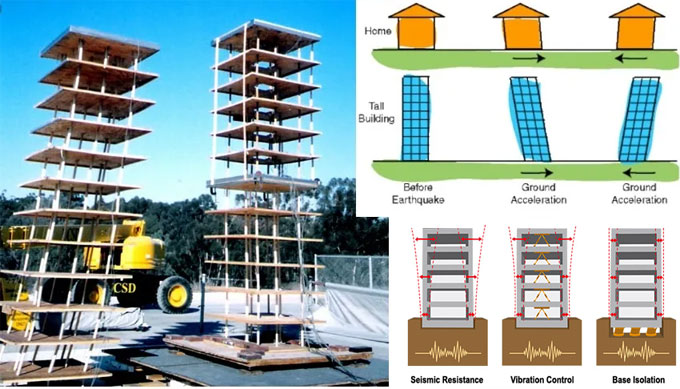
Guidelines for Earthquake Resistant Design of Structures in India: Ensuring Safety amidst Seismic Risks

India is a region prone to seismic activity, with several parts of the country lying in high seismic zones. The frequency and intensity of earthquakes pose significant challenges to the safety and stability of structures. In light of these risks, implementing earthquake-resistant design guidelines is crucial to mitigate potential damage and safeguard human lives.
Understanding Seismic Hazards in India
Before delving into earthquake-resistant design guidelines, it is essential to grasp the seismic hazards prevalent in India. The country is divided into four seismic zones based on the frequency and intensity of earthquakes.
These zones range from Zone II (least hazardous) to Zone V (most hazardous). States like Jammu and Kashmir, Himachal Pradesh, Uttarakhand, North-Eastern states, and parts of Gujarat, Maharashtra, Bihar, and West Bengal fall under high-risk seismic zones.
Key Guidelines for Earthquake-Resistant Design
Compliance with Building Codes:
The Bureau of Indian Standards (BIS) has formulated the Indian Standard Code of Practice for Earthquake Resistant Design and Construction of Buildings (IS 1893). Engineers and architects must adhere to these codes while designing structures in seismic zones. The code provides guidelines for determining seismic forces, designing lateral load-resisting systems, and selecting suitable materials to enhance earthquake resilience.
Seismic Analysis and Design Parameters:
Conducting a thorough seismic analysis is imperative to understand the behavior of structures under earthquake loading. Engineers utilize various methods such as response spectrum analysis and time history analysis to evaluate seismic forces and design parameters. Factors like soil type, building height, and structural system influence the seismic design approach.
Strength and Ductility:
Earthquake-resistant structures should possess adequate strength and ductility to withstand seismic forces without collapsing. Employing ductile materials like reinforced concrete and steel enhances the structure's ability to dissipate energy during an earthquake. Reinforced concrete frames with ductile detailing and steel moment-resisting frames are commonly used systems for seismic-resistant construction.
Proper Foundation Design:
The foundation is the backbone of any structure, especially in seismic zones where soil dynamics play a significant role. Engineers must design foundations capable of bearing vertical loads and resisting lateral forces induced by earthquakes. Techniques like pile foundations, raft foundations, and base isolation systems help mitigate seismic effects on the structure.
Reinforcement Detailing:
Effective reinforcement detailing is critical for ensuring the ductile behavior of structures during earthquakes. Engineers must pay attention to proper spacing, cover, and lap lengths of reinforcement bars as per design codes. Seismic detailing provisions include the use of seismic ties, shear reinforcement, and adequate anchorage lengths to prevent brittle failure.
Redundancy and Continuity:
Incorporating redundancy and continuity in structural systems improves the overall robustness of buildings against seismic forces. Redundant elements provide alternative load paths in case of localized damage, reducing the risk of progressive collapse. Continuous load paths ensure that forces are distributed uniformly throughout the structure, minimizing concentrated stress points.
Non-Structural Elements:
Apart from the primary structural system, non-structural elements such as partitions, cladding, and utilities require special attention in seismic design. These components are vulnerable to damage during earthquakes and may pose hazards to occupants if not adequately secured. Seismic bracing, flexible connections, and damping systems are employed to mitigate non-structural risks.
Quality Control and Construction Practices:
Maintaining high-quality construction standards is essential for achieving earthquake resilience. Strict adherence to approved drawings, material specifications, and construction techniques is crucial to ensure structural integrity.
Regular inspections and quality control measures during construction help identify and rectify potential deficiencies that could compromise seismic performance.
Case Studies and Best Practices
To reinforce the importance of earthquake-resistant design guidelines, examining successful case studies and best practices is instructive.
The seismic retrofitting of historical monuments like the Qutub Minar in Delhi and the Brihadeeswarar Temple in Tamil Nadu showcases innovative techniques to enhance structural stability while preserving architectural heritage. Additionally, the implementation of base isolation technology in critical infrastructure projects such as hospitals and bridges exemplifies cutting-edge seismic design practices.
Challenges and Future Directions
Despite significant advancements in seismic engineering, several challenges persist in the implementation of earthquake-resistant design guidelines in India. These include inadequate enforcement of building codes, lack of awareness among stakeholders, and economic constraints affecting retrofitting of existing structures.
Addressing these challenges requires collaborative efforts from government agencies, industry professionals, and academia to prioritize seismic safety and resilience in urban development projects.
Conclusion
In conclusion, adhering to earthquake-resistant design guidelines is paramount for ensuring the safety and resilience of structures in seismic-prone regions of India. By integrating seismic principles into the design, construction, and maintenance phases, engineers can minimize the impact of earthquakes on buildings and infrastructure.
To learn more, watch the following video tutorial.
Video Source: Civil Engineering (Concrete & Structural Engg.)
Continued research, education, and awareness initiatives are essential to foster a culture of seismic safety and mitigate the risks posed by natural disasters in the built environment. Through concerted efforts and proactive measures, India can build a more resilient future amidst seismic uncertainties.


